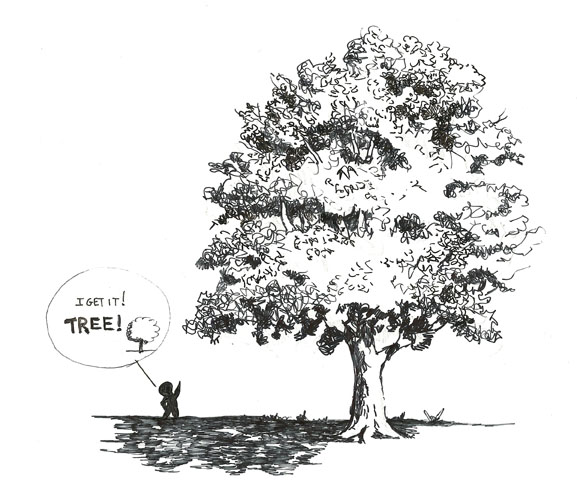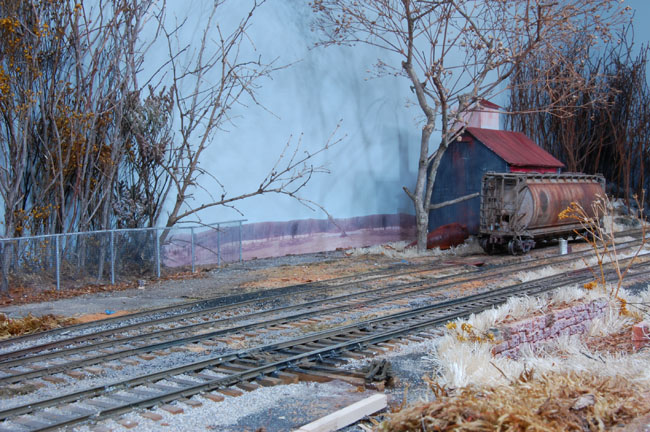One of the hardest things beginning art students have to overcome is their own preconceived idea about how things look. Too often beginners tend to draw what’s in their mind instead of what’s actually in front of them.
Take a tree form for example. Most people tend to picture a puffball on a stick or a triangle of some kind. Real trees, however, come in an amazing variety of shapes and sizes. The reasons we do this go way beyond the scope of this post, but I will touch on one: We are creatures that form mental concepts. By that I mean that once we gain an understanding of something, we tend to apply that understanding to other things that seem similar to the first. Going back to our example, once we have the concept of a “tree” in our minds, we tend to lump all types of trees under the same concept driven umbrella, even though a ponderosa pine tree is very different in shape and texture than a spruce tree.
Concepts are good in that they allow us to learn about and navigate the world from a young age. They tend to be bad when we fail to grow beyond the basic level of understanding that simple concepts provide. How is this a problem for beginning artists and railroad modelers? Simple: concepts can get in the way of a deeper understanding of the world around us. They can also interfere with how we represent that world in the form of a two-dimensional painting or a three-dimensional model scene.
As an example, we know that trees often tower over a train in the real world, yet historically modelers have been reluctant to use this ratio in miniature. Why? My guess is that a concept of some kind is at work. Maybe something like the trains are more important than model trees. Or you need to see the train at all times in case something goes wrong. Or perhaps scale height trees take up too much space, overpower the trains and get in the way of doing maintenance. Who knows? While all of those reasons may or may not be valid, the bias against placing a scale height tree on a layout is so strong that modelers seldom do it, even if a scene would be greatly enhanced as a result. Yes, I know that tall objects do seem to overpower the train in a model scene, but don’t they do so in the real world too? And isn’t the lack of that ratio one of the reasons a model scene often doesn’t ring true?
Another benefit of learning to see accurately is that you begin to notice all the elements in a scene, not just a few. Most modelers simply focus on the trains with scenery often treated as background filler. This is fine as far as it goes. However, in learning to pay attention, discrepancies and shortcomings become more apparent to the eye because the modeler is seeing objects and the relationships between them as they actually are, perhaps for the first time. Preconceptions tend to dull the mind. If you think you already know something, then you tend to stop examining it closely and also stop learning about it. For railroad modelers, curiosity can be a good thing. What a concept! (Ugh.)
Regards,
Mike


I agree Mike. My take on it is that people are so interested in the trains that they don’t want anything to detract from them. Unfortunately, that leaves them open to having some unrealistic scenes, because, well, trees ARE big and even relatively young ones are taller than the trains. Another possibility is that when we are railfanning or sitting at a crossing, the train dominates the scene. Not only is a train large, but there is a presence that a train has with it’s sight, sound and even the air that it displaces that a train grabs your attention. On the other hand, trees don’t, unless you are talking about Sequoias.
Here is another reason for making trees prototypically large, they will dominate and take the focus off of the trains. Now some people might say, ” wait a minute, that’s a BAD thing!” Is it really? What if our modeling is not that great, or we need to do a little more work to a particular locomotive. If the scenery is done RIGHT our focus will be drawn to the SCENE and not individual models. It will also look right. Tonly Koester has said that when people came over to the Allegeny Midland, they would say, “oh what a great railroad!” But he himself has said that no one part of it was really a standout as a greatly detailed model, but he worked hard at getting the “feel” of the railroad right. In this case, I am advocating delving into details, but the overall details of a scene so that it looks more like reality. To do that, however, we need to pay attention to the little details.
Hi Jim,
Yes, historically, thanks to the magazines, the focus has almost exclusively been on the trains. We do call it model railroading and not model forestry. However, I’m with you and I submit that a lack of focus and information on how to faithfully render scenery realistically instead of impressionistically is also a factor. Most articles usually treat it as an after thought or filler. It’s been the rare article indeed that treated the subject as one worthy of study in its own right. We’re planning on doing something about that soon.
Regards,
Mike Cougill